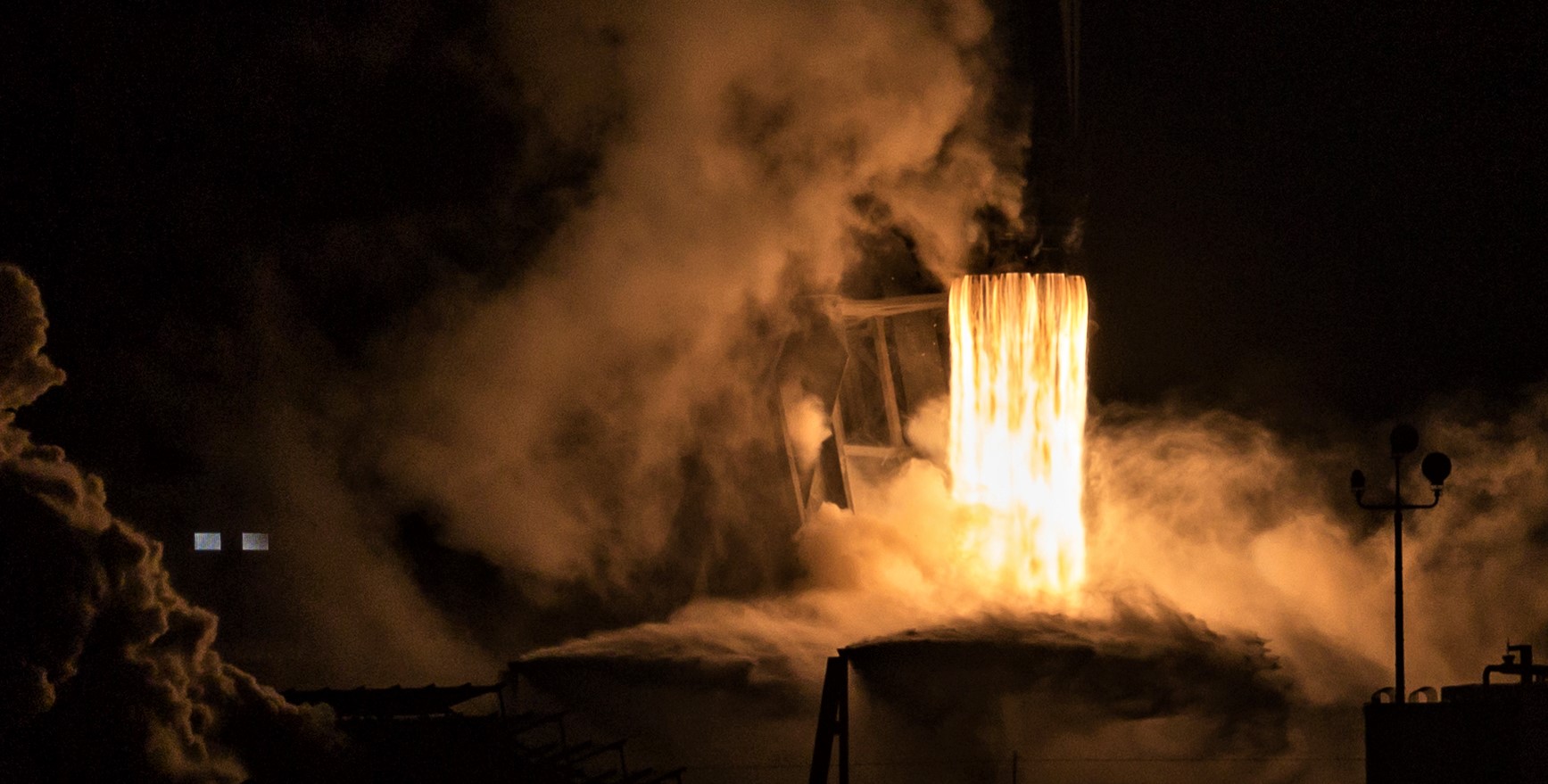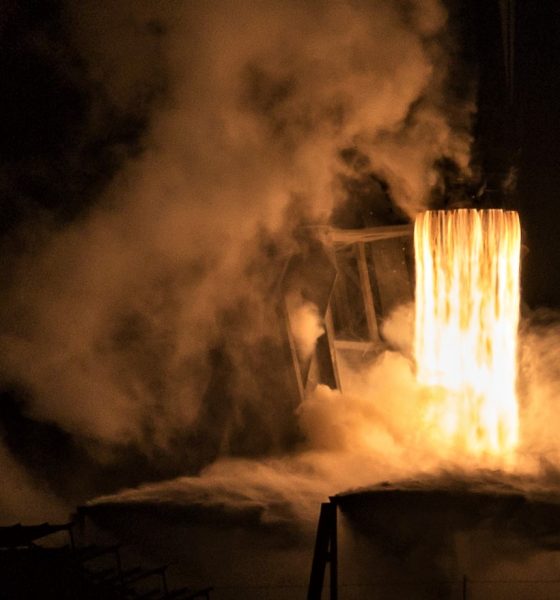

News
SpaceX static fires Falcon 9 with satellites on board for the first time in years
SpaceX has successfully completed a Falcon 9 static fire ahead of Starlink’s first dedicated launch, breaking a practice that dates back to Falcon 9’s last catastrophic failure to date.
That failure occurred in September 2016 around nine minutes before a planned Falcon 9 static fire test, completely destroying the rocket and the Amos-6 communications satellite payload and severely damaging Launch Complex 40 (LC-40). Since that fateful failure, all 42 subsequent Falcon 9 and Falcon Heavy satellite launches have been preceded by static fire tests without a payload fairing attached. This process typically adds 24-48 hours of work to launch operations, an admittedly tiny price to pay to reduce the chances of a rocket failure completely destroying valuable payloads. With Starlink v0.9, SpaceX is making different choices.
When supercool liquid oxygen ruptured a composite overwrapped pressure vessel (COPV) in Falcon 9’s upper stage, the resultant explosion and fire destroyed Falcon 9. Perhaps more importantly, the ~$200M Amos-6 satellite installed atop the rocket effectively ceased to exist, a loss that posed a serious threat to the livelihood of its owner, Spacecom. Posed with a question of whether saving a day or two of schedule was worth the potential destruction of customer payloads, both customers, SpaceX, and their insurers obviously concluded that static fires should be done without payloads aboard the rocket.
The only exceptions since Amos-6 are the launch debuts of Falcon Heavy – with a payload that was effectively disposable and SpaceX-built – and Crew Dragon DM-1, in which Falcon 9’s integration with Dragon’s launch abort system had to be tested as part of the static fire. Every other SpaceX rocket launch since September 2016 has excluded payloads during each routine pre-flight static fire.


SpaceX’s Spacecraft Emporium
Why the change of pace on this launch, then? The answer is simple: for the first time ever, SpaceX is both the sole payload/satellite stakeholder and launch provider, meaning that nearly all of the mission’s risk – and the consequences of failure – rest solely on SpaceX’s shoulders. In other words, SpaceX built and owns the Falcon 9 assigned to the mission, the 60 Starlink test satellites that make up its payload, and the launch complex supporting the mission.
Even then, if Falcon 9 were to fail during an internal SpaceX mission, customer launches could be seriously delayed by both the subsequent failure investigation failure and any potential damage to the launch complex. In short, although an internal mission does offer SpaceX some unique freedoms, it is still in the company’s best interest to treat the launch like any other, even if some customer-oriented corners are likely begging to be cut. Additionally, the loss of SpaceX’s first dedicated payload of 60 Starlink satellites could be a significant setback for the constellation, although it may be less significant than most would assume.

This is not to say that SpaceX won’t take advantage of some of the newfound freedom permitted by Starlink launches. In fact, CEO Elon Musk has stated that one of SpaceX’s 2019 Starlink missions will become the first to reuse a Falcon fairing. Additionally, SpaceX is free to do things that customers might be opposed to but that the company’s own engineers believe to be low-risk. Notably, Starlink missions will be an almost perfect opportunity for SpaceX to flight-prove reusability milestones without having to ask customers to tread outside of their comfort zones.
The sheer scale of SpaceX proposed Starlink constellation – two phases of ~4400 and ~12,000 satellites – means that the company will need all the latent launch capacity it can get over the next 5-10 years, at least until Starship/Super Heavy is able to support internal missions. Extraordinary packing density will help to minimize the number of launches needed, but the fact remains that even an absurd 120 satellites per launch (double Starlink v0.9’s 60) would still require an average of 12 launches per year to finish Starlink before 2030.


In the meantime, thoughts of a dozen or more annual Starlink launches are somewhat premature. SpaceX’s first dedicated Starlink launch (deemed Starlink v0.9) is scheduled to lift off no earlier than 10:30 pm EDT (02:30 UTC), May 15th, and is being treated as an advanced but still intermediary step between the Tintin prototypes and a finalized spacecraft design. Still, in an unprecedented step, SpaceX has built sixty Starlink satellites for the development-focused mission, in stark contrast to the six satellites (still a respectable achievement) competitor OneWeb launched in February 2019 as part of its own flight-test program.
Check out Teslarati’s Marketplace! We offer Tesla accessories, including for the Tesla Cybertruck and Tesla Model 3.

Elon Musk
Elon Musk and Tesla AI Director share insights after empty driver seat Robotaxi rides
The executives’ unoccupied tests hint at the rapid progress of Tesla’s unsupervised Robotaxi efforts.

Tesla CEO Elon Musk and AI Director Ashok Elluswamy celebrated Christmas Eve by sharing personal experiences with Robotaxi vehicles that had no safety monitor or occupant in the driver’s seat. Musk described the system’s “perfect driving” around Austin, while Elluswamy posted video from the back seat, calling it “an amazing experience.”
The executives’ unoccupied tests hint at the rapid progress of Tesla’s unsupervised Robotaxi efforts.
Elon and Ashok’s firsthand Robotaxi insights
Prior to Musk and the Tesla AI Director’s posts, sightings of unmanned Teslas navigating public roads were widely shared on social media. One such vehicle was spotted in Austin, Texas, which Elon Musk acknowleged by stating that “Testing is underway with no occupants in the car.”
Based on his Christmas Eve post, Musk seemed to have tested an unmanned Tesla himself. “A Tesla with no safety monitor in the car and me sitting in the passenger seat took me all around Austin on Sunday with perfect driving,” Musk wrote in his post.
Elluswamy responded with a 2-minute video showing himself in the rear of an unmanned Tesla. The video featured the vehicle’s empty front seats, as well as its smooth handling through real-world traffic. He captioned his video with the words, “It’s an amazing experience!”
Towards Unsupervised operations
During an xAI Hackathon earlier this month, Elon Musk mentioned that Tesla owed be removing Safety Monitors from its Robotaxis in Austin in just three weeks. “Unsupervised is pretty much solved at this point. So there will be Tesla Robotaxis operating in Austin with no one in them. Not even anyone in the passenger seat in about three weeks,” he said. Musk echoed similar estimates at the 2025 Annual Shareholder Meeting and the Q3 2025 earnings call.
Considering the insights that were posted Musk and Elluswamy, it does appear that Tesla is working hard towards operating its Robotaxis with no safety monitors. This is quite impressive considering that the service was launched just earlier this year.
Elon Musk
Starlink passes 9 million active customers just weeks after hitting 8 million
The milestone highlights the accelerating growth of Starlink, which has now been adding over 20,000 new users per day.

SpaceX’s Starlink satellite internet service has continued its rapid global expansion, surpassing 9 million active customers just weeks after crossing the 8 million mark.
The milestone highlights the accelerating growth of Starlink, which has now been adding over 20,000 new users per day.
9 million customers
In a post on X, SpaceX stated that Starlink now serves over 9 million active users across 155 countries, territories, and markets. The company reached 8 million customers in early November, meaning it added roughly 1 million subscribers in under seven weeks, or about 21,275 new users on average per day.
“Starlink is connecting more than 9M active customers with high-speed internet across 155 countries, territories, and many other markets,” Starlink wrote in a post on its official X account. SpaceX President Gwynne Shotwell also celebrated the milestone on X. “A huge thank you to all of our customers and congrats to the Starlink team for such an incredible product,” she wrote.
That growth rate reflects both rising demand for broadband in underserved regions and Starlink’s expanding satellite constellation, which now includes more than 9,000 low-Earth-orbit satellites designed to deliver high-speed, low-latency internet worldwide.
Starlink’s momentum
Starlink’s momentum has been building up. SpaceX reported 4.6 million Starlink customers in December 2024, followed by 7 million by August 2025, and 8 million customers in November. Independent data also suggests Starlink usage is rising sharply, with Cloudflare reporting that global web traffic from Starlink users more than doubled in 2025, as noted in an Insider report.
Starlink’s momentum is increasingly tied to SpaceX’s broader financial outlook. Elon Musk has said the satellite network is “by far” the company’s largest revenue driver, and reports suggest SpaceX may be positioning itself for an initial public offering as soon as next year, with valuations estimated as high as $1.5 trillion. Musk has also suggested in the past that Starlink could have its own IPO in the future.
News
NVIDIA Director of Robotics: Tesla FSD v14 is the first AI to pass the “Physical Turing Test”
After testing FSD v14, Fan stated that his experience with FSD felt magical at first, but it soon started to feel like a routine.

NVIDIA Director of Robotics Jim Fan has praised Tesla’s Full Self-Driving (Supervised) v14 as the first AI to pass what he described as a “Physical Turing Test.”
After testing FSD v14, Fan stated that his experience with FSD felt magical at first, but it soon started to feel like a routine. And just like smartphones today, removing it now would “actively hurt.”
Jim Fan’s hands-on FSD v14 impressions
Fan, a leading researcher in embodied AI who is currently solving Physical AI at NVIDIA and spearheading the company’s Project GR00T initiative, noted that he actually was late to the Tesla game. He was, however, one of the first to try out FSD v14.
“I was very late to own a Tesla but among the earliest to try out FSD v14. It’s perhaps the first time I experience an AI that passes the Physical Turing Test: after a long day at work, you press a button, lay back, and couldn’t tell if a neural net or a human drove you home,” Fan wrote in a post on X.
Fan added: “Despite knowing exactly how robot learning works, I still find it magical watching the steering wheel turn by itself. First it feels surreal, next it becomes routine. Then, like the smartphone, taking it away actively hurts. This is how humanity gets rewired and glued to god-like technologies.”
The Physical Turing Test
The original Turing Test was conceived by Alan Turing in 1950, and it was aimed at determining if a machine could exhibit behavior that is equivalent to or indistinguishable from a human. By focusing on text-based conversations, the original Turing Test set a high bar for natural language processing and machine learning.
This test has been passed by today’s large language models. However, the capability to converse in a humanlike manner is a completely different challenge from performing real-world problem-solving or physical interactions. Thus, Fan introduced the Physical Turing Test, which challenges AI systems to demonstrate intelligence through physical actions.
Based on Fan’s comments, Tesla has demonstrated these intelligent physical actions with FSD v14. Elon Musk agreed with the NVIDIA executive, stating in a post on X that with FSD v14, “you can sense the sentience maturing.” Musk also praised Tesla AI, calling it the best “real-world AI” today.








